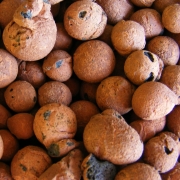- Error
{Re}habitat
Learn how adaptive reuse and upcycling can add hip design to your home, apartment, or yard with the Go Green channel's {Re}habitat series. Follow host Rachael Ranney as she shows you how to repurpose salvaged and found materials, adding fun and function to your space without breaking your budget.

Light Expanded Clay Aggregate (LECA) masonry block, which was used in the construction of the Landskrona Townhouse, is a low embodied energy material, is relatively inexpensive, is lightwieght, has a high insulation R-value, and is made by heating the materials to 1200 degrees Celsius in a rotary kiln. The origins of LECA and other aggregates such as Gravelite, Perlite, and Rocklite can be traced back to the invention of Haydite (invented for the construction of the USS Selma) in 1917 in Kansas City, Missouri. In Europe, LECA block was first used in Denmark, Germany, Holland, and the U.K.
For years, design shows have been busy emptying the world’s quarries of as much granite as possible in the name of kitchen countertops. The harvesting of stone, as well as its shipping and processing, can leave a significant environmental footprint. A small number of companies, such as Cold Spring Granite (which has architectural, memorial, and residential products), prioritize sustainability. Meanwhile, green manufacturers have been coming up with a number of attractive and highly functional alternatives.
For years, design shows have been busy emptying the world’s quarries of as much granite as possible in the name of kitchen countertops. The harvesting of stone, as well as its shipping and processing, can leave a significant environmental footprint. A small number of companies, such as Cold Spring Granite (which has architectural, memorial, and residential products), prioritize sustainability. Meanwhile, green manufacturers have been coming up with a number of attractive and highly functional alternatives.
“Paint is a big, big piece of the puzzle,” says Steele. “A lot of times it’s the first thing that gets changed when people decide they want to go green because it requires a low commitment level.”
Roof gardens can be divided into two categories: extensive and intensive. Extensive roof gardens, which are more common and less complicated, are typically constructed to a depth of 6” and are frequently designed to meet specific performance goals. Intensive roof gardens, which can be relatively deep, commonly include large plants, trees, and elaborate gardens that require much maintenance. Key benefits of roof gardens include controlling stormwater run-off, mitigating urban heat island effects, and reducing sound reflection and transmission.
Reflective roofs made of thermoplastic membranes composed of thermoplastic polyolefin (TPO) are often recommended because of their high reflectivity and environmental friendliness, qualities that won the approval of the CRRC for Title 24. Fotopoulos Building Industries, Inc. (FBI), representing Firestone Building Products, prescribes TPO membranes to their customer base. Color plays a central part in reflectivity, and the membranes accordingly come in white, tan, and gray. Paul Hatch, the territory manager of FBI’s San Diego market, states that the TPO membranes that FBI uses have a Solar Reflectance Index (SRI) of 102. (The SRI is based on the percentage of heat and light reflected by a roof, and very cool roofs can have values exceeding 100.) Individually, the reflectance of light for TPO is 0.79 or 79%, and the reflectance of heat for TPO is 0.85 or 85%. Another reason that Hatch, and FBI, favor TPO membranes above other reflective roofing systems is that TPO membranes are made of a recyclable material that is high-quality and easy to apply. Hatch says that the TPO membranes are durable, taking traffic better than other waterproofing materials. TPO prefabricated pipe boots are also good for covering exposed pipes on a roof because they preclude the need for black mastic type sealant and require little to no maintenance.
The economic case for installing solar electric panels on your house or place of business is a heavily discussed topic these days. With the green building movement in full force, photovoltaic (PV) systems are becoming more and more popular. In many cases, though, homeowners and small business owners lack the necessary information to make an educated decision on whether to go ahead with a photovoltaic (PV) system installation. In order to make an educated decision on a PV system, the owner must approach the purchase with the return on investment (ROI) in mind.
Water consumption and reduction is a hot topic in many parts of the world these days. Often times, simple methods can lead to major reductions in water consumption. Most people don’t realize that toilets alone can account for nearly 30% of a home’s indoor water consumption. In addition, a toilet made before 1994 can use over three times the water a new toilet uses. It is for those reasons that a toilet replacement makes perfect sense.

